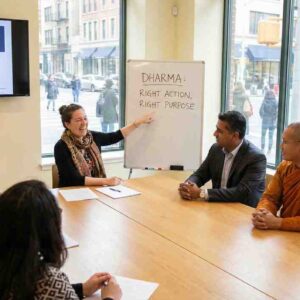Balancing Heritage and Modernity in the Face of Changing Times
Lucknow– Uttar Pradesh, a state rich in cultural heritage and deeply rooted in traditional philosophies, stands at a crossroads as its youth navigate the pull of modernity. While some young people are embracing their heritage through renewed interest in festivals, art, and spiritual practices, others are distancing themselves from traditions they see as restrictive or irrelevant to contemporary life. This dynamic raises pressing questions: Is the state’s younger generation rejecting its philosophical roots, or are they finding innovative ways to integrate them into their modern lives?
Key Metrics
- Youth Demographics: Uttar Pradesh has over 35% of its population aged 15-35, making it one of the largest youth demographics in India (Census 2011).
- Digital Influence: Approximately 60% of youth in urban areas and 35% in rural areas actively use digital platforms, exposing them to global trends and modern philosophies (TRAI Report, 2023).
- Education Trends: Enrollments in arts and philosophy programs at state universities have decreased by 18% over the past decade, reflecting a decline in formal engagement with traditional philosophies (UP Education Department).
- Cultural Participation: Events like the Kumbh Mela 2019 saw over 2 crore young attendees, indicating continued interest in cultural traditions.
Youth Engagement with Traditional Philosophies
1. Embracing Heritage: The Revival of Traditions
Despite globalization, many young people in Uttar Pradesh are reconnecting with their roots through cultural practices and spiritual exploration.
- Festivals and Rituals: Celebrations like Janmashtami, Holi, and Navratri have seen increased participation from the younger generation, often blending traditional elements with modern forms of expression like music festivals and social media campaigns.
- Yoga and Meditation: Initiatives such as the International Day of Yoga have brought ancient practices into modern wellness routines, appealing to young professionals seeking balance in their hectic lives.
2. Rejecting Outdated Norms: Questioning Tradition
For some, traditional philosophies are seen as rigid, perpetuating outdated social norms and limiting individual freedom.
- Caste-Based Practices: Many urban and educated youth are rejecting caste-based social structures, advocating for equality and meritocracy instead.
- Gender Roles: Young women, in particular, are questioning patriarchal traditions, calling for a reinterpretation of philosophical texts to promote gender equality.
Digital Platforms: A Double-Edged Sword
1. Spreading Awareness
Digital platforms have enabled young people to access and learn about their heritage in new ways, from online courses on the Bhagavad Gita to Instagram reels celebrating local crafts and rituals.
- Example: The Digi Shakti Program has distributed over 50 lakh tablets and smartphones, helping rural youth connect with online resources on traditional arts and history.
2. Diluting Traditions
However, the internet also exposes youth to global cultures, sometimes at the expense of local traditions. Fast-paced content often reduces complex philosophies to simplified or commercialized narratives.
Philosophical Reflections on the Shift
1. The Middle Path: A Buddhist Perspective
The teachings of the Buddha, first shared in Sarnath, emphasize theMiddle Path, advocating balance rather than extremes.
- Application Today: Many youth in Uttar Pradesh are finding ways to adopt modern values like equality and innovation while respecting cultural roots. For example, combining yoga with fitness trends or using festivals to advocate social causes.
2. The Bhakti Movement’s Relevance
The Bhakti movement, which challenged orthodoxy and promoted personal connection with the divine, resonates with youth seeking a spiritual but non-institutional approach to philosophy.
- Example: Young artists in cities like Varanasi are reviving devotional music with contemporary elements, drawing inspiration from Kabir’s poetry and Sufi traditions.
3. Gandhian Ideals
Mahatma Gandhi’s principles of simplicity and nonviolence appeal to environmentally conscious youth movements.
- Modern Interpretation: From eco-friendly festivals to community service programs, many initiatives align with Gandhian thought on sustainable living and social harmony.
Challenges in Bridging the Divide
- Disconnect with Rural Youth
- While urban youth have access to resources that make traditions more accessible and appealing, rural areas face challenges like lack of infrastructure and modern educational tools.
- Over-Commercialization of Culture
- The commercialization of festivals and traditions risks alienating youth who seek authenticity in their engagement with heritage.
- Generational Gap
- Older generations often resist reinterpretations of traditions, creating tension in families and communities.
Steps to Reconnect Youth with Traditional Philosophies
- Integrating Philosophy in Education
- Schools and colleges should incorporate lessons from texts like the Bhagavad Gita, Kabir’s poetry, and Ambedkar’s works into curricula, fostering critical engagement with tradition.
- Promoting Creative Expression
- Support young artists and innovators who reinterpret traditional philosophies through music, art, and digital platforms.
- Encouraging Inclusive Practices
- Reform outdated customs that alienate youth, promoting traditions that reflect values of equality and inclusion.
- Leveraging Technology
- Expand digital archives of traditional philosophies, making them accessible and engaging through apps and multimedia content.
Conclusion: A Balancing Act
The youth of Uttar Pradesh are neither wholly embracing nor entirely rejecting traditional philosophies. Instead, they are engaging in a dynamic process of reinterpretation, blending ancient wisdom with contemporary values.
In this evolving landscape, the challenge lies in ensuring that traditions remain relevant and inclusive while empowering young people to contribute their creativity and vision. The future of Uttar Pradesh’s philosophical heritage depends on its ability to adapt to the aspirations of its youth while staying true to its timeless essence.












